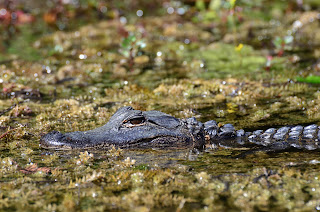After our trip to El Salvador we flew to Miami and attempted to rendezvous with my brother Jim, his girlfriend Julie, Julie's son Jake and my sister Joanne as they were driving back from Naples along the Tamiami Trail. This road runs along the northeast edge of Everglades National Park then cuts through Big Cypress National Preserve. I was amazed at all the birds and alligators along the road. We stopped off at the Oasis Visitor Center where we saw huge gaters sunning themselves!
Hunting had decimated their population and the American alligator was listed as an endangered species back in 1973. Subsequent conservation efforts have allowed their numbers to increase and the species was removed from the list in 1987. There are estimated to be 200,000 alligators in the Everglades and one and a half million in the state of Florida - a reason for this gator to smile!
The alligator is an apex predator or top of the food chain. Other than humans, alligators don't have enemies. They consume fish, amphibians, reptiles, birds and mammals. The teeth of the alligator are designed to grip prey but can not rip or chew flesh like some other predators can.
They can live up to 30 to 50 years old and can reach 13 feet in length! Nearby an Anhinga was drying her wings. Unlike other water birds, an Anhinga does not have oil glands to water proof it's feathers. The bird has to wait until it's wings are dry before it can fly or re-submerge.
This bird is often mistaken for the Double-crested Cormorant due to its similar size and behavior. However, the two species can be differentiated by their tails and bills. The tail of the Anhinga is wider and much longer than that of the cormorant. The bill of the Anhinga is pointed, while the bill of the cormorant has a hook-tip as you can see in this close up of a Double-crested Cormorant.
By the way, we never did meet up with my brother and sister until back at his home in Palm Beach Gardens. Our brief visit to the Everglades only whetted our appetites so we returned on December 5th to look for more birds and other critters. This time we drove to Royal Palm and walked along the Anhinga Trail. A beautiful Swamp Lily was blooming along the trail.
The birds did not disappoint us and being used to humans allowed us to approach quite closely. Black Vultures were hanging out alongside the trail. They are smaller and do not have red heads like our Turkey Vultures. Even though you're not supposed to feed the wildlife, they must be getting food from the tourists as you can almost touch them. It did make for a great photo.
The other birds were not so tame but Marc still got some great shots. The first is of a Great Blue Heron.
We almost missed this beautiful Purple Gallinule but when we went back to investigate a splash I spotted him among the reeds. Fortunately, he came out on the lilypads to feed on some larvae and Marc was able to photograph him.
I can't decide who's more stunning, the Purple Gallinule or this Green Heron. You can decide for yourself.
Further along the boardwalk a Peninsula Cooter (left) and a Florida Red-bellied Cooter (right) were sunning themselves on a log.
We headed back to our car where a pair of Red-bellied Woodpeckers were nesting in a tree nearby. The male is shown here as he is red on top of his head to his bill while the female is red only on the nape.
We decided to drive through the park to the tiny town of Flamingo. Along the way we passed a guy photographing something along the side of the road. We stopped to investigate. Black Vultures were feeding on an Alligator carcass!
Not everything in nature is pleasant or beautiful but the vultures were doing their job. They were disposing of the carcass thus helping to prevent the spread of disease. We can't be sure how the gator died but it was most likely hit by a car. We arrived in Flamingo situated on the shore of Florida Bay. Here the freshwater of the Everglades meets the saltwater of the Gulf of Mexico. We spotted another alligator near the marina but closer inspection revealed a crocodile! Alligators have a broader snout with overlapping jaws and darker coloration than a crocodile. They are also less tolerant of seawater but more tolerant of colder climates than crocodiles. The crocodile was sunning himself on the shore but slipped silently into the water.
It was getting late and time to head back to my brother's. Along the way we spotted some wood storks feeding in a marsh.
The wood stork is an indicator species in that it's health is directly linked to the health of the Everglades. Problems with the quality, quantity, timing and distribution of water have led to the decline of the Wood Stork. In the 1960's there were 5000 nesting birds but by the 1980's there were as few as 500 nesting birds. They are now listed as federally endangered. Efforts are underway to save the Everglades and the animals that live here. In 1989 Congress extended the eastern park boundary and authorized the world's largest restoration act. It will take 30 years to execute the plan and only time will tell if it is successful at restoring one of the most unique habitats in the world.
























































